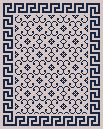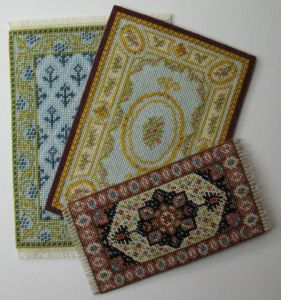On this page you can see all of my free rug designs. The thumbnails give an idea of the different designs and their relative sizes. Click on the thumbnails to go to pages where you can download the charts. Of course the gauze counts are just suggestions - some people stitch my designs on much larger counts, and use them in 1:24 and larger scales.
The pattern charts are all in PDF format, and each can be downloaded in color, or as black and white symbols. If your computer says it can't open PDF files, you need to download and install the free viewer Adobe Acrobat® Reader.
The cross stitch calculator at about.com can calculate the size in inches or metric on any count gauze. (Due to limitations in my charting software, the charts have rug sizes in inches only.)
More needlepoint resources at my site
1:48 designs
I usually chart my 1:48 scale rugs for 48 count gauze. For me, 48 count is the perfect trade-off between in-scale detail and ease of stitching. Plus, a single strand of DMC floss is perfect for stitching on 48 count. DMC floss is easy to find, affordable compared to silk thread and such, and comes in a huge color range.
If you want to use a significantly larger count gauze for your 1:48 scale rugs, some of the 1:144 scale rug charts may work as well!
| 1:48 Oriental | Stitch count | Thread colors | |
|---|---|---|---|
 1800 Baluch
1800 Baluch |
32×56 or 62×81 stitches | 4 colors |
The smaller chart is based on a very small rug that I've seen online, while the larger is an example of how it would turn out with more repeats added.
The full-scale rug was so tiny that the smaller of my charts would be in perfect scale only if stitched on 80 or 90 count!
Several years ago, I charted the same rug for 1:12 scale, for the Swedish mini magazine Miniatyrvärlden. |
|
|
45×73 stitches | 6 colors | A perfectly in-scale version of the original when stitched on 54 count. But 48 count works just as well. |
| 48×93 stitches | 5 colors | The busy background can be stitched a single color for a different look - go to the rug's page for an example pic. | |
 1880 Heriz 1880 Heriz |
53×95 stitches | 7 colors | Closely based on a huge full-scale rug, but the miniature version turned out rather too small - it could actually be used as a huge 1:144 scale rug. In any case, it was fun to see how few stitches I could use while still capturing the essentials of the design. |
|
|
49×73 stitches | 4 colors | Add more repeats for a larger rug. Many afghan rugs have much smaller octagons, so with more repeats this design could easily work in larger scales. |
| 1:48 Georgian and 18th century | Stitch count | Thread colors | |
|---|---|---|---|
 Neoclassical Neoclassical |
89×97 stitches | 7 colors |
 Based on an antique design for a rug - a painted design sheet with no size or date given.
The design probably dates to the 2nd half of the 18th century.
Based on an antique design for a rug - a painted design sheet with no size or date given.
The design probably dates to the 2nd half of the 18th century.
I played around with colors to create a Wedgwood inspired color scheme too. |
| 1:48 Victorian and 19th century | Stitch count | Thread colors | |
|---|---|---|---|
 1850 Savonnerie 1850 Savonnerie |
65×89 stitches | 8 colors | Isn't it pretty - I wouldn't mind having a full-scale one! |
 1880 Aubusson 1880 Aubusson |
83×119 stitches | 10 colors | This design is based on a room size rug measuring 722×484 cm (23'9"×15'11"). Sizewise, it would be a true 1:48 scale if stitched on 20 count, and 1:144 scale if stitched on 60 count... |
 Bell pulls Bell pulls |
6–7 stitches wide | 2 to 10 colors | Make them as long or short as you like. In larger scales, you could use these charts for bookmarks, braces, and curtain pull backs. I stitched mine on 48 count gauze, and they measure about 3.5×32 mm (1/8"×1-1/4"). |
| 1:48 Arts & Crafts and 20th century | Stitch count | Thread colors | |
|---|---|---|---|
 1902 Arts & Crafts 1902 Arts & Crafts |
95×119 stitches | 4 colors | It's in scale when stitched on 48 count gauze, but as it's so large it would work fine for larger scales as well. |
|
1910 Stickley |
31×57 or 47×71 stitches | 4 colors |
Gustav Stickley, leader of the American Arts&Crafts movement, designed a number of so-called drugget rugs to use with his furniture.
These were coarse flatweave rugs with bold repeating designs and fringed ends.
I provide charts for two sizes. The smaller is based on a rug I've actually seen online, while the larger is an example of how it would turn out with more repeats added. |

1910 Stickley |
35×67 or 67×83 stitches | 3 colors |

1910 Stickley |
33×61 or 103×129 stitches | 2 colors | More Stickley rugs. This is a design I've seen in different sizes - the large ones have a proper border; the small ones just a plain stripe. |
| 49×69 stitches | 5 colors | The may be the easiest of my 1:48 rugs, as there's very little counting and only two colors in each square or border. |
1:144 designs
In general, I think stitching on 60 or higher counts makes the rugs look the best for 1:144, and I don't think you should go lower than to 48 count gauze in this scale, but it's all really a matter of taste. Personally, I'm much more comfortable with 48 count than 60 count.
If you like stitching on extremely fine gauze like 90 count, or if you simply need a really large rug, do consider the rugs labeled as 1:48 scale too.
| 1:144 Oriental | Stitch count | Thread colors | |
|---|---|---|---|
| 39×67 stitches. | 4 colors | This design is based on an antique piece that was described as a seat cover rather than a rug. But it was 1.4 m (3.5 ft) long, so sizewise I think it qualifies as a rug. | |
| 29×53 stitches | 6 colors | The full-scale rug was rather small, so this one is exactly 1:144 scale when stitched on 72 count gauze. But it would be just as nice stitched on a different count. | |
| 30×42 stitches | 4 colors | The simplest design of all - if you're new to small-scale needlepoint, I suggest you start with this one. | |
| 39×57 stitches | 5 colors | Stitched on 48 count gauze, this rug looks great in a 1:144 room. To me, this proves that you don't have to use insanely small count gauze for small scales. |
| 1:144 Georgian | Stitch count | Thread colors | |
|---|---|---|---|
| 41×41 stitches | 4 colors | You can change the size of this one by adding or skipping stitches. | |
| 37×53 stitches | 3 colors | This rug can easily be adapted to any color scheme - it uses a light, medium, and dark shade of a single color. |
| 1:144 Victorian | Stitch count | Thread colors | |
|---|---|---|---|
| 45×55 stitches. | 9 colors | It doesn't get more Victorian than this. Suggested for experienced needlepointers only, due to the number of colors and complex design. |
